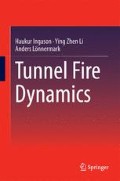Abstract
Visibility is very important for evacuation during a fire and, therefore, a very important parameter for fire safety in a tunnel. There are different methods for estimating the visibility in smoke-filled spaces, using mass-specific extinction coefficient or the mass optical density. For both methodologies there are experimental values available for some materials of interest. First, the mass extinction coefficient methodology is presented and at the end compared and correlated to the mass optical density methodology. Values of these parameters for selected materials are presented and conversion of values for one of the parameters into the other is discussed. Finally, the effect on the walking speed during egress is discussed.
Access this chapter
Tax calculation will be finalised at checkout
Purchases are for personal use only
References
Mulholland GW, Liggett W, Koseki H (1997) The Effect of Pool Fire Diameter on the Property of Smoke Produced by Crude Oil Fires. Fire Science and Technology 17 (1):64–69
Widmann JF, Yang JC, Smith TJ, Manzello SL, Mulholland GW (2003) Measurement of the optical extinction coefficients of post-flame soot in the infrared. Combustion and Flame 134:119–129
Mulholland GW, Choi MY Measurement of the Mass Specific Extinction Coefficient for Acetylene and Ethene Smoke Using the Large Agglomerate Optics Facility. In: Twenty-Seventh Symposium (International) on Combustion, 1998. The Combustion Institute, pp 1515–1522
Jin T, Yamada T (1985) Irritating Effects of Fire Smoke on Visibility. Fire Science and Technology 5 (1):79–89
Jin T (2008) Visibility and Human Behavior in Fire Smoke. In: The SFPE Handbook of Fire Protection Engineering. National Fire Protection Engineering, pp 2–54 -- 52–66
Mulholland G, Croarkin C (2000) Specific Extinction Coefficient of Flame Generated Smoke. Fire and Materials 24:227–230
Mulholland GW, Johnsson EL, Fernandez MG, Shear DA (2000) Design and Testing of a New Smoke Concentration Meter. Fire and Materials 24:231–243
ISO (2007) Life-threatening components of fire—Guidelines for estimation of time available for escape using fire data. ISO 13571:2007
Tewarson A (1988) Generation of Heat and Chemical Compounds in Fires. In: DiNenno PJ, Beyler CL, Custer RLP, Walton WD, Watts JM (eds) SFPE Handbook of Fire Protection Engineering. First Edition edn. NFPA, pp 1–179 -- 171–199
Tewardson A (2008) Generation of Heat and Gaseous, Liquid, and Solid Products in Fires. In: SFPE Handbook of Fire Protection Engineering. NFPA, pp 2–109 -- 103–194
Ingason H (2012) Fire Dynamics in Tunnels. In: Beard AN, Carvel RO (eds) In The Handbook of Tunnel Fire Safety, 2nd Edtion ICE Publishing, London, pp 273–304
Steinert C Smoke and Heat Production in Tunnel Fires. In: The International Conference on Fires in Tunnels, Borås, Sweden, 10–11 October 1994. SP Swedish National Testing and Research Institute, pp 123–137
Ingason H, Lönnermark A, Li YZ (2011) Runehamar Tunnel Fire Tests. SP Report 2011:55. SP Technicial Research Institute of Sweden, Borås, Sweden
Frantzich H, Nilsson D (2003) Utrymning genom tät rök: beteende och förflyttning. Avd. för brandteknik, Lunds tekniska högskola, Lund
Fridolf K (2014) Walking speed as function of extinction coefficient. Personal communication, Jan. 10,
Jin T (1978) Visibility through smoke. Journal of Fire & Flamability 9:135–157
Fridolf K, Andrée K, Nilsson D, Frantzich H (2013) The impact of smoke on walking speed. Fire and Materials
BFS (2011) Boverkets allmänna råd om analytisk dimensionering av byggnaders brandskydd. Boverkets Författningsamling, BFS 2011:27 BBRAD (in Swedish)
Frantzich H (2000) Utrymning av tunnelbanaetåg—Experiemntell utvärdering av möjligheten att utrymma i spårtunnel. Räddningsverket, Karlstad
Author information
Authors and Affiliations
Corresponding author
Rights and permissions
Copyright information
© 2015 Springer Science+Business Media New York
About this chapter
Cite this chapter
Ingason, H., Li, Y., Lönnermark, A. (2015). Visibility. In: Tunnel Fire Dynamics. Springer, New York, NY. https://doi.org/10.1007/978-1-4939-2199-7_14
Download citation
DOI: https://doi.org/10.1007/978-1-4939-2199-7_14
Published:
Publisher Name: Springer, New York, NY
Print ISBN: 978-1-4939-2198-0
Online ISBN: 978-1-4939-2199-7
eBook Packages: EngineeringEngineering (R0)

